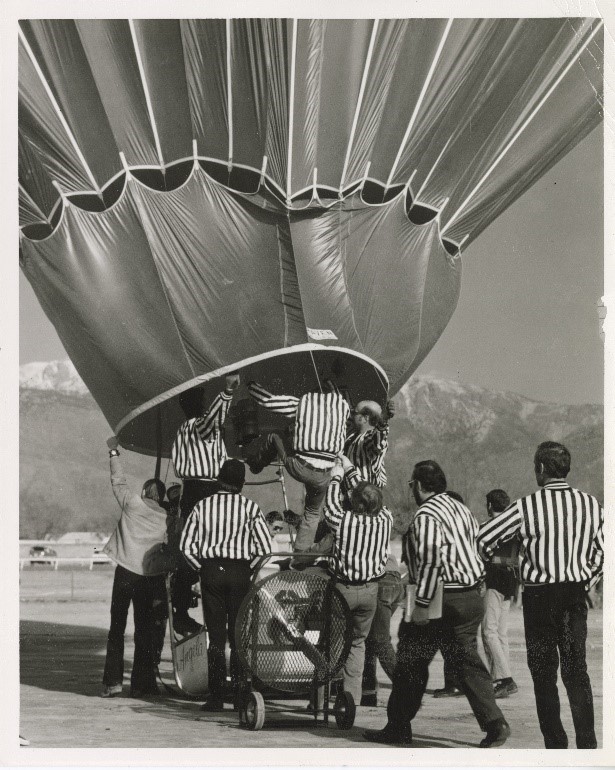Rolling out the Red Carpet for the First World Hot Air Balloon Championship
'The World Hot Air Balloon Championship Comes to the Land of Enchantment'
Part 2 - the story of the event
By Rebecca Prinster, Assistant Curator, Anderson Abruzzo Albuquerque International Balloon Museum
(In the first installment of this 50th anniversary series on the World Hot Air Balloon Championship, we learned that Albuquerque, New Mexico, was the only city to put in a bid to host the international competition. The organisers planned the event for February 1973, thinking the weather then would be great for hot air ballooning.)
Throughout the latter half of 1972, the organisers of the first Albuquerque International Balloon Fiesta® were hard at work planning the second annual event, which would include the first-ever World Hot Air Balloon Championship. Sid Cutter, Tom Rutherford, and Don Draper of World Balloon Championships, Inc. envisioned a weeklong event with a parade, a ball, and a queen contest. Fun flying events were scheduled to take place after each morning’s competitive task. The organisers had set a budget of $100,000, which Rutherford later admitted was probably a little low.
32 pilots competed
They sent invitations to 54 Fédération Aéronautique Internationale (FAI) member nations, and fourteen responded. Participating countries were allowed up to four pilots who were chosen by their respective country’s national aero club. The minimum age for pilot entry was nineteen, and each competitor had to have at least 50 hours of balloon flying experience. Only one pilot was allowed in the basket during competition events.
The conditions for participation for the U.S. delegation were different than for other countries. One spot was guaranteed to the most recent U.S. national champion, who in 1972 was Bruce Comstock. The other three U.S. competitors flew in qualifying events the week before the world championship commenced. From a field of forty-nine pilots, Bill Cutter, Dennis Floden, and Tom Oerman emerged victorious, rounding out the American team.
In addition to the U.S. contingent, pilots represented Sweden, the Netherlands, Belgium, France, Germany, Denmark, Great Britain, Switzerland, Australia, Canada, Ireland, Norway, and Italy. Some of these pilots were Per-Olow Anderson (SWE), Jan Balkedal (SWE), Don Cameron (GBR), Peter Vizzard (AUS), Franco Segre (ITA) and one female competitor, Anneke Sandel (NED). There were thirty-two competing pilots in all.

Jan Balkedal of Sweden making final flight preparations at the first World Hot Air Balloon Championship, 1973; Courtesy of the Sid Cutter Estate
World Balloon Championships, Inc. pulled out all the stops for their international guests. A local jeweler was commissioned to design a money clip with a Montgolfiere balloon on it, and this was given to international pilots with a one-hundred-dollar bill folded inside. They also had the U.S. Postal Service issue a commemorative 15-cent airmail envelope on the first day of the event, 10 February 1973.

Safety officials at the first World Hot Air Balloon Championship, 1973; Courtesy of the Sid Cutter Estate
four different tasks
Because the FAI was sanctioning the world championship event, competition tasks had to first be approved by this governing body. Sid Cutter invited Ed Yost—sometimes nicknamed “Sir Launch-a-Lot”—to be Clerk of the Course, and the two brainstormed ideas to comprise the competition. There was some back and forth with the FAI initially, as they deemed some of Cutter and Yost’s ideas too dangerous.
Finally, the FAI approved four different tasks: a hare and hound race and three barograph flights (a flight profile test, a rapid climb and leveled-off flight, and a climb-and-descent flight). For these three tasks, pilots would have to fly a determined flight pattern inscribed on the smoked drum inside the barograph. The barograph would trace a pilot’s altitude and time spent within the calibrated flight pattern.
The barograph component caused some controversy among the pilots, and there were protests against including these scores in the final tally. Yost and Rutherford diplomatically settled the disputes, though, and the scores were included in the overall point counts.

Rules and regulations for the competitive barograph flights at the first World Hot Air Balloon Championship; AAAIBM Dennis Floden Collection
challenging conditions
In addition to the protests, there were other memorable learning experiences at the first World Hot Air Balloon Championship. Even in New Mexico, February can be a wintery month, and on the last day of competition, pilots found themselves flying in snow. Visibility was low as they flew a yo-yo pattern in the climb-and-descent flight. Another day, some pilots flew into high-security areas on Manzano Base (now part of Kirtland Air Force Base), had their cameras confiscated, and likely faced interrogation.
Ultimate success
But that first world championship is ultimately remembered as a success. Dennis “Denny” Floden of the U.S. finished first, having mastered barograph flying before coming to Albuquerque. Bill Cutter of the U.S. took second, and Jan Balkedal of Sweden finished in third place. National and international media coverage had been extensive and helped spur on the growth of hot air ballooning.
On the final day of the event, 17 February, 126 balloons lifted off together in the largest mass ascension up until then. At the time, that number represented about half of the world’s hot air balloon population. The success of the first event meant that two years later, competitors would return to Albuquerque for the 1975 World Hot Air Balloon Championship.
Header image: Balloons preparing to launch in the first World Hot Air Balloon Championship, 1973; Copyright Dick Kent Photography, LLC

